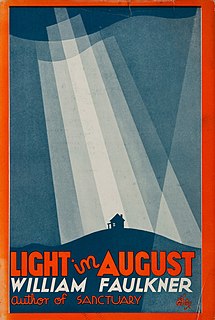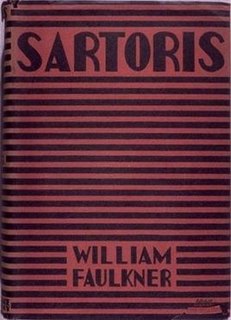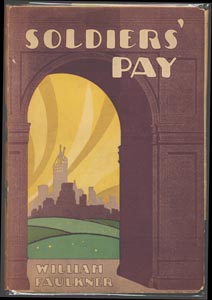Related Research Articles

William Cuthbert Faulkner was an American writer known for his novels and short stories set in the fictional Yoknapatawpha County, based on Lafayette County, Mississippi, where Faulkner spent most of his life. A Nobel Prize laureate, Faulkner is one of the most celebrated writers of American literature and is considered the greatest writer of Southern literature.

Light in August is a 1932 novel by the Southern American author William Faulkner. It belongs to the Southern gothic and modernist literary genres.

The Sound and the Fury is a novel by the American author William Faulkner. It employs several narrative styles, including stream of consciousness. Published in 1929, The Sound and the Fury was Faulkner's fourth novel, and was not immediately successful. In 1931, however, when Faulkner's sixth novel, Sanctuary, was published—a sensationalist story, which Faulkner later said was written only for money—The Sound and the Fury also became commercially successful, and Faulkner began to receive critical attention.

Yoknapatawpha County is a fictional Mississippi county created by the American author William Faulkner, largely based upon and inspired by Lafayette County, Mississippi, and its county seat of Oxford. Faulkner often referred to Yoknapatawpha County as "my apocryphal county".

Sartoris is a novel, first published in 1929, by the American author William Faulkner. It portrays the decay of the Mississippi aristocracy following the social upheaval of the American Civil War. The 1929 edition is an abridged version of Faulkner's original work. The full text was published in 1973 as Flags in the Dust. Faulkner's great-grandfather William Clark Falkner, himself a colonel in the American Civil War, served as the model for Colonel John Sartoris. Faulkner also fashioned other characters in the book on local people from his hometown Oxford. His friend Ben Wasson was the model for Horace Benbow, while Faulkner's brother Murry served as the antetype for young Bayard Sartoris.

As I Lay Dying is a 1930 Southern Gothic novel by American author William Faulkner. Faulkner's fifth novel, it is consistently ranked among the best novels of 20th-century literature. The title derives from Book XI of Homer's Odyssey, wherein Agamemnon tells Odysseus, "As I lay dying, the woman with the dog's eyes would not close my eyes as I descended into Hades."
Thomas Sutpen is a focal character of William Faulkner's 1936 novel Absalom, Absalom! Sutpen arrives in Faulkner's imaginary Yoknapatawpha County, Mississippi, in the 1830s and establishes a 64,000-acre (100-square-mile) plantation, Sutpen's Hundred, in an attempt to create his own dynasty. It is eventually revealed that Sutpen was born to a poor white family in what became West Virginia before moving to the Tidewater region of Virginia, where he was the first privy to the aristocratic plantation culture of the Antebellum South.

Go Down, Moses is a 1942 collection of seven related pieces of short fiction by American author William Faulkner, sometimes considered a novel. The most prominent character and unifying voice is that of Isaac McCaslin, "Uncle Ike", who will live to be an old man; "uncle to half a county and father to no one". Though originally published as a short story collection, Faulkner considered the book to be a novel in the same way The Unvanquished is considered a novel. Because of this, most editions no longer print "and other stories" in the title.

Intruder in the Dust is a 1948 novel about an African American farmer accused of murdering a Caucasian man. Nobel Prize–winning American author William Faulkner.
Ikkemotubbe is a fictional Chickasaw Indian chief living in Yoknapatawpha County, Mississippi. He appears in novels and short stories of William Faulkner, such as in the collection of stories titled III The Wilderness: "Red Leaves," "A Justice," and "A Courtship". He is referenced extensively in Faulkner's popular classic 'The Bear" as the original owner of the land that was sold to Carothers McCaslin, the first white landowner of the woods in which the story takes place. After a steamboat trip to New Orleans, his name is "Frenchified" to "L'Homme" or "De l'Homme", which he himself later re-Anglicizes to "Doom."

The Reivers: A Reminiscence, published in 1962, is the last novel by the American author William Faulkner. The bestselling novel was awarded the Pulitzer Prize for Fiction in 1963. Faulkner previously won this award for his book A Fable, making him one of only four authors to be awarded it more than once. Unlike many of his earlier works, it is a straightforward narration and eschews the complicated literary techniques of his more well known works. It is a picaresque novel, and as such may seem uncharacteristically lighthearted given its subject matter. For these reasons, The Reivers is often ignored by Faulkner scholars or dismissed as a lesser work. He previously had referred to writing a "Golden Book of Yoknapatawpha County" with which he would finish his literary career. It is likely that The Reivers was meant to be this "Golden Book". The Reivers was adapted into a film of the same name directed by Mark Rydell and starring Steve McQueen as Boon Hogganbeck.

The Hamlet is a novel by the American author William Faulkner, published in 1940, about the fictional Snopes family of Mississippi. Originally a standalone novel, it was later followed by The Town (1957), and The Mansion (1959), forming the "Snopes trilogy."

The Mansion is a novel by the American author William Faulkner, published in 1959. It is the last in a trilogy of books about the fictional Snopes family of Mississippi, following The Hamlet and The Town.

Requiem for a Nun is a work of fiction written by William Faulkner. It is a sequel to Faulkner's early novel Sanctuary, which introduced the characters of Temple Drake, her friend Gowan Stevens, and Gowan's uncle Gavin Stevens. The events in Requiem are set in Faulkner's fictional Yoknapatawpha County and Jackson, Mississippi, in November 1937 and March 1938, eight years after the events of Sanctuary. In Requiem, Temple, now married with a child, must learn to deal with her violent, turbulent past as related in Sanctuary.

Soldiers' Pay is the first novel published by the American author William Faulkner. It was originally published by Boni & Liveright on February 25, 1926. It is unclear if Soldiers' Pay is the first novel written by Faulkner. It is however the first novel published by the author. Faulkner was working on two manuscripts while finishing Soldiers' Pay.
"Red Leaves" is a short story by American author William Faulkner. First published in the Saturday Evening Post on October 25, 1930, it was one of Faulkner's first stories to appear in a national magazine. The next year the story was included in These 13, Faulkner's first collection of short stories.
"Spotted Horses" is a novella written by William Faulkner and originally published in Scribner's magazine in 1931. It includes the character Flem Snopes, who appears in much of Faulkner's work, and tells in ambiguous terms of his backhand profiteering with an honest Texan selling untamed ponies. Spotted Horses was later incorporated into The Hamlet under the title "The Peasants: Chapter One". It features V.K Ratliff who appears in other Faulkner short stories and is a prominent character in The Hamlet, The Town and The Mansion.
"Mountain Victory" is a short story by American author William Faulkner, first published in the October 12, 1932 issue of The Saturday Evening Post. The story is unusual among Faulkner's works in that it takes place outside of his fictional Yoknapatawpha County. It deals with historical themes common to much of Faulkner's later work, including social and racial divisions in the South following the American Civil War.
Knight’s Gambit is a 1949 short story collection by American author William Faulkner. Including the titular story, the book collects six of Faulkner’s stories about attorney Gavin Stevens, who also takes a leading part in his novel Intruder in the Dust (1948).
Gavin Stevens is a lawyer and the county attorney in Jefferson in Faulkner’s fictional Yoknapatawpha County, Mississippi. He was educated at Harvard and Heidelberg universities.
References
- Kirk, Robert W.; Klotz, Marvin (1965). Faulkner's People: A complete guide and index to the characters and fiction of William Faulkner. Los Angeles: University of California Press.